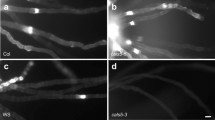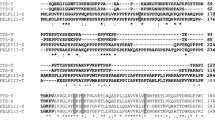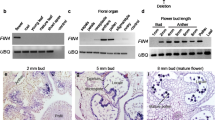Abstract
Class III pistil-specific extensin-like proteins (PELPIII) are chimeric hydroxyproline-rich glycoproteins with properties of both extensins and arabinogalactan proteins. The abundance and specific localization of PELPIII in the intercellular matrix (IM) of tobacco (Nicotiana tabacum) stylar transmitting tissue, and translocation of PELPIII from the IM into the pollen tube wall after pollination, presume the biological function of these glycoproteins to be related to plant reproduction. Here we show that in in vitro assays the translocation of PELPIII is specifically directed to the callose inner wall of the pollen tubes, indicating that protein transfer is not dependent on the physiological conditions of the transmitting tract. We designed a set of experiments to elucidate the biological function of PELPIII in the stylar IM. To study the function of the specific interaction between PELPIII proteins and the pollen tube wall, one of the PELPIII proteins (MG15) was ectopically expressed in pollen tubes and targeted to the tube wall. We also generated transgenic tobacco plants in which PELPIII proteins were silenced. In vitro bioassays were performed to test the influence of purified PELPIII on pollen tube growth, as compared to tobacco transmitting tissue-specific proteins (TTS) that were previously shown to stimulate pollen tube growth. The various tests described for activity of PELPIII proteins all gave consistent and mutually affirmative results: the biological function of PELPIII proteins is not directly related to pollen tube growth. These data show that similar stylar glycoproteins may act very differently on pollen tubes.









Similar content being viewed by others
References
Atkinson AH, Lind JL, Clarke AE, Anderson MA (1994) Molecular and structural features of the pistil of Nicotiana alata. Biochem Soc Symp 60:15–26
Baldwin TC, McCann MC, Roberts K (1993) A novel hydroxyproline-deficient arabinogalactan protein secreted by suspension-cultured cells of Daucus carota: purification and partial characterization. Plant Physiol 103:115–123
Bosch M, Sommer Knudsen J, Derksen J, Mariani C (2001) Class III pistil-specific extensin-like proteins from tobacco have characteristics of arabinogalactan proteins. Plant Physiol 125:2180–2188
Bradford MM (1976) A rapid and sensitive method for the quantitation of microgram quantities of protein utilizing the principle of protein-dye binding. Anal Biochem 72:248–254
Chen C, Mau S, Clarke AE (1993) Nucleotide sequence and style-specific expression of a novel proline-rich protein from Nicotiana alata. Plant Mol Biol 21:391–395
Cheung AY, Wu HM (1999) Arabinogalactan proteins in plant sexual reproduction. Protoplasma 208:87–98
Cheung AY, May B, Kawata EE, Gu Q, Wu HM (1993) Characterization of cDNAs for stylar transmitting tissue-specific proline-rich proteins in tobacco. Plant J 3:151–160
Cheung AY, Wang H, Wu H (1995) A floral transmitting tissue-specific glycoprotein attracts pollen tubes and stimulates their growth. Cell 82:383–393
Cheung AY, Zhan X, Wang H, Wu H (1996) Organ-specific and agamous-regulated expression and glycosylation of a pollen tube growth-promoting protein. Proc Natl Acad Sci USA 93:3853–3858
Edge ASB, Faltynek CR, Hof L, Reichert LE Jr, Weber P (1981) Deglycosylation of glycoproteins by trifluoromethanesulfonic acid. Anal Biochem 118:131–137
Fincher GB, Stone BA, Clarke AE (1983) Arabinogalactan-proteins: structure, biosynthesis, and function. Annu Rev Plant Physiol 34:47–70
Frankis R, Mascarenhas JP (1980) Messenger RNA in the ungerminated pollen grain: a direct demonstration of its presence. Ann Bot 45:595–599
Gleeson PA, Clarke AE (1979) Structural studies on the arabinogalactan-protein from the stylar canal of Gladiolus gandavensis. Biochem J 181:607–621
Goldberg RB (1988) Plants: novel developmental processes. Science 240:1460–1467
Goldberg RB, Hoshek G, Tam SH, Ditta GS, Breidenbach RW (1981) Abundance, diversity, and regulation of mRNA sequence sets in soybean embryogenesis. Dev Biol 83:201–217
Goldman MHS, Pezzotti M, Seurinck J, Mariani C (1992) Developmental expression of tobacco pistil-specific genes encoding novel extensin-like proteins. Plant Cell 4:1041–1051
Graaf BHJ de (2000) Pistil proline-rich proteins in Nicotiana tabacum, their involvement in pollen-pistil interaction. PhD thesis, University of Nijmegen, Nijmegen, The Netherlands
Graaf BHJ de, Derksen JWM, Mariani C (2001) Pollen and pistil in the progamic phase. Sex Plant Reprod 14:41–55
Graaf BHJ de, Knuiman BA, Derksen J, Mariani C (2003) Characterization and localization of the transmitting tissue-specific PELPIII proteins of Nicotiana tabacum. J Exp Bot 54:55–63
Heslop-Harrison J (1987) Pollen germination and pollen-tube growth. Int Rev Cytol 107:1–78
Higashiyama T, Yabe S, Sasaki N, Nishimura Y, Miyagishima S, Kuroiwa H, Kuroiwa T (2001) Pollen tube attraction by the synergid cell. Science 293:1480–1483
Higgins DG, Sharp PM (1988) Clustal: a package for performing multiple sequence alignments on a microcomputer. Gene 73:237–244
Hülskamp M, Schneitz K, Pruitt RE (1995) Genetic evidence for a long-range activity that directs pollen tube guidance in Arabidopsis. Plant Cell 7:57–64
Jung J (1956) Sind Narbe und Griffel Eintrittspforten für Pilzinfektionen? Phytopathol Z 27:405–426
Kho YO, Baer J (1968) Observing pollen tubes by means of fluorescence. Euphytica 17:298–302
Kroh M, Labarca C, Loewus F (1971) Use of pistil exudate for pollen tube wall biosynthesis in Lillium Longiflorum. In: Heslop-Harrison J (ed) Pollen: development and physiology. Butterworths, London, pp 273–278
Kuboyama T, Chung CS, Takeda G (1994) The diversity of interspecific pollen-pistil incongruity in Nicotiana. Sex Plant Reprod 7:250–258
Laemmli UK (1970) Cleavage of structural proteins during assembly of the heads of bacteriophage T4. Nature 227:680–685
Lind JL, Bacic A, Clarke AE, Anderson MA (1994) A style-specific hydroxyproline-rich glycoprotein with properties of both extensins and arabinogalactan proteins. Plant J 6:491–502
Linskens HF, Esser KL (1957) Über die spezifische Anfärbung der Pollenschläuche im Griffel und die Zahl der Kallosepfropfen nach Selbstbefruchtung und Fremdbefruchtung. Naturwissenschaften 44:1–2
Lush WM (1999) Whither chemotropism and pollen tube guidance? Trends Plant Sci 4:413–418
Mascarenhas J (1993) Molecular mechanisms of pollen tube growth and differentiation. Plant Cell 5:1303–1314
McClure BA, Cruz GF, Beecher B, Sulaman W (2000) Factors affecting inter- and intraspecific pollen rejection in Nicotiana. Ann Bot 85:113–123
Pennell RI, Janniche L, Kjellbom P, Scofield GN, Peart JM, Roberts K (1991) Developmental regulation of a plasma membrane arabinogalactan protein epitope in oilseed rape flowers. Plant Cell 3:1317–1326
Read SM, Clarke AE, Bacic A (1993) Stimulation of growth of cultured Nicotiana tabacum W38 pollen tubes by poly (ethylene glycol) and Cu(II) salts. Protoplasma 177:1–14
Rosen WG (1971) Pollen tube growth and fine structure. In: Heslop-Harrison J (eds) Pollen: development and physiology. Butterworths, London, pp 177–185
Roy S, Jauh GY, Hepler PK, Lord EM (1998) Effects of Yariv phenylglycoside on cell wall assembly in the lily pollen tube. Planta 204:450–458
Sánchez AM (2001) Pollen-pistil interaction in Nicotiana: study of an incongruous cross. PhD thesis, University of Nijmegen, Nijmegen, The Netherlands
Schultz CJ, Hauser K, Lind JL, Atkinson AH, Pu ZY, Anderson MA, Clarke AE (1997) Molecular characterisation of a cDNA sequence encoding the backbone of a style-specific 120 kDa glycoprotein which has features of both extensins and arabinogalactan proteins. Plant Mol Biol 35:833–845
Shimizu KK, Okada K (2000) Attractive and repulsive interactions between female and male gametophytes in Arabidopsis pollen tube guidance. Development 127:4511–4518
Showalter AM (1993) Structure and function of plant cell wall proteins. Plant Cell 5:9–23
Sommer-Knudsen J, Clarke AE, Bacic A (1996) A galactose-rich, cell-wall glycoprotein from styles of Nicotiana alata. Plant J 9:71–83
Sommer-Knudsen J, Clarke AE, Bacic A (1997) Proline- and hydroxyproline-rich gene products in the sexual tissues of flowers. Sex Plant Reprod 10:253–260
Sommer-Knudsen J, Lush WM, Bacic A, Clarke AE (1998) Re-evaluation of the role of a transmitting tract-specific glycoprotein on pollen tube growth. Plant J 13:529–535
Taylor LP, Hepler PK (1997) Pollen germination and tube growth. Annu Rev Plant Physiol Plant Mol Biol 48:461–491
Wang H, Wu HM, Cheung AY (1993) Development and pollination regulated accumulation and glycosylation of a stylar transmitting tissue-specific proline-rich protein. Plant Cell 5:1639–1650
Wang H, Wu HM, Cheung AY (1996) Pollination induces mRNA poly(A) tail-shortening and cell deterioration in flower transmitting tissue. Plant J 9:715–727
Weterings K, Reijnen W, van Aarssen R, Kortstee A, Spijkers J, van Herpen M, Schrauwen J, Wullems G (1992) Characterization of a pollen-specific cDNA clone from Nicotiana tabacum expressed during microgametogenesis and germination. Plant Mol Biol 18:1101–1111
Wittink FRA, Knuiman B, Derksen J, Capkova V, Twell D, Schrauwen JAM, Wullems GJ (2000) The pollen-specific gene Ntp303 encodes a 69-kDa glycoprotein associated with the vegetative membranes and the cell wall. Sex Plant Reprod 12:276–284
Wu H, Wang H, Cheung AY (1995) A pollen tube growth stimulatory glycoprotein is deglycosylated by pollen tubes and displays a glycosylation gradient in the flower. Cell 82:395–403
Wu H, Wong E, Ogdahl J, Cheung AY (2000) A pollen tube growth-promoting arabinogalactan protein from Nicotiana alata is similar to the tobacco TTS protein. Plant J 22:165–176
Yariv J, His H, Katchalski E (1967) Precipitation of arabic acid and some seed polysaccharides by glycosylphenylazo dyes. Biochem J 105:10–20
Acknowledgements
We gratefully thank Alice Cheung and colleagues of the Department of Biochemistry and Molecular Biology, University of Massachusetts, for providing facilities and hospitality for the pollen tube growth assays. Bruce McClure is thanked for the gift of the 120 kDa-antibody.
Author information
Authors and Affiliations
Corresponding author
Rights and permissions
About this article
Cite this article
Bosch, M., Derksen, J. & Mariani, C. A functional study of stylar hydroxyproline-rich glycoproteins during pollen tube growth. Sex Plant Reprod 16, 87–98 (2003). https://doi.org/10.1007/s00497-003-0179-3
Received:
Accepted:
Published:
Issue Date:
DOI: https://doi.org/10.1007/s00497-003-0179-3




